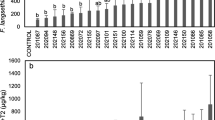Abstract
Naturally infected ears of corn were examined for presence of mycotoxins and colonizingFusaria. In kernels of cobs with symptoms of pink fusariosis /pink ear rot/ which stated about 95% cobs naturally infected was present moniliformin in amount 30–530 mg/kg.Fusarium suhglutinans /W&R/N,T&M was dominating species in this type of ear fusariosis. In handly selected kermels of cobs with symptoms of red fusariosis /red ear rot/ which stated only about 5% of infected cobs, were present: zearalenone up 20 mg/kg, deoxynivalenol /vomitoxin/ up 170 mg/kg and 3-acetyldeoxynivalenol up 40 mg/kg. In axial stems the amount of mycotoxins was 1.5–8 times higer than in kernels.
Similar content being viewed by others
References
Bottaiico A, Lerario P and Visconti A (1984). Production of zearalenone, trichothecenes and moniliformin by Fusarium species from cereals in Italy. p 199–208 In: H Kurata and Y Ueno /ed/. Toxigevic fungi — their toxins and health hazard. Kodansha Ltd, Tokyo and Elsevier Sci Publ. Amsterdam.
Chelkowski J, Visconti A, Solfrizzo M, Bottalico A (1984) Formation of mycotoxins by Fusarium species from cereals in Poland. Phytopath medit 23: 43–46
Chelkowski J, Kwasna H, Zajkowski P, Visconti A and Bottalico A (1987). Fusarium sporotriChioides Sherb. and trichothecens associated with Fusarium ear rot of corn before harvest. Mycotoxin Research, 3:111
Miller JD, Young JCh, Trenholm HL (1983).Fusarium toxins in field corn. Time course of fungal growth and production of deoxyni val enol and other mycotoxins. Can J Plant Pathol 5: 11–16
Nelson PE, Toussoun TA, Marasas WFO (1983). Fusarium species. An Illustrated Manual for Identification. The Pennsylvania State University Press, University Park and London.
Shuh M, Glawischnig E, Leibetseder J (1982). Natura occurence of mycotoxicoses in Austria associated with mycotoxin-contaminated feedstuff. Proseedings V Int. IUPAC Symp “Mycotoxins and Pytotoxins”. Technical University Viena, p. 118-121
Tuite J, Shaner G, Rambo S, Foster J, Caldwell RW (1974). The Giberella ear rot epidemics of corn in Indiana in 1965 and 1972. Cereal Science Today 19: 238–240
Visconti A, Chelkowski J and Bottalico A (1986). Deoxynivalenol and 3acetyldeoxynivalenol, mycotoxins associated with wheat head fusariosis in Poland. Mycotoxin Research 2: 39–64
Young JC, Miller JD (1985). Appaerance of fungus ergosterol and Fusarium mycotoxins in the husk, axial stems and stalk after ear inoculation of field corn. Can J Plant Sci 65: 47–53
Zajkowski P, Kwasna H (1987). Corn cob fusariosis — natural infection of various genotypes in 1985 and 1986. Mycotoxin Research, p95
Author information
Authors and Affiliations
Rights and permissions
About this article
Cite this article
Chelkowski, J., Zajkowski, P., Zawadzki, M. et al. Moniliformin, deoxynivalenol, 3Acetyldeoxynivalenol and zearalenone — Mycotoxins associated with corn cob fusariosis in Poland. Mycotox Res 3 (Suppl 1), 25–27 (1987). https://doi.org/10.1007/BF03192020
Issue Date:
DOI: https://doi.org/10.1007/BF03192020




